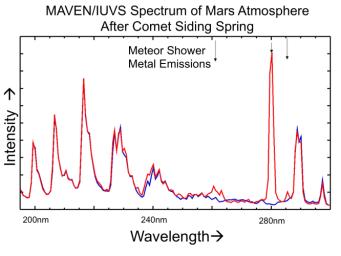Comet Meteor Shower Put Magnesium and Iron into Martian Atmosphere
Caption:
The places where the red line on this graph extends higher than the blue line show detection of metals added to the Martian atmosphere from dust particles released by a passing comet.
The graphed data are from the Imaging Ultraviolet Spectrograph (IUVS) on NASA's MAVEN spacecraft, which recorded the intensities of emission by ingredients in the Martian atmosphere just before (blue line) and after (red line) comet C/2013 A1 Siding Spring sped within about 87,000 miles (139,500 kilometers) of Mars on Oct. 19, 2014.
The "before" line records the usual main gases in the atmosphere, primarily carbon dioxide and its byproducts. The "after" line includes those plus peaks at 280 nanometer wavelength -- a fingerprint of ionized magnesium -- and other wavelengths that are fingerprints of iron. Researchers interpret this change as a result of vaporization of dust particles that came from the comet and entered the Martian atmosphere at high speed.
IUVS uses limb scans to map the chemical makeup and vertical structure across Mars' upper atmosphere.
Background Info:
MAVEN is NASA's Mars Atmosphere and Volatile Evolution (MAVEN) spacecraft. NASA Goddard Space Flight Center in Greenbelt, Md., manages the MAVEN project for NASA's Science Mission Directorate, Washington, and built some of the science instruments for the mission. MAVEN's principal investigator is based at the University of Colorado's Laboratory for Atmospheric and Space Physics in Boulder. The university provided science instruments and leads science operations, as well as education and public outreach, for the mission. Lockheed Martin Space Systems, Denver, built and operates the spacecraft. The University of California at Berkeley's Space Sciences Laboratory provided instruments for the mission. NASA's Jet Propulsion Laboratory, a division of the California Institute of Technology in Pasadena, provides navigation and Deep Space Network support, as well as the Electra telecommunications relay hardware and operations.
For more information about MAVEN, visit
http://www.nasa.gov/maven
and
http://lasp.colorado.edu/home/maven/
.
For more information about NASA's Mars Exploration Program, see
http://marsprogram.jpl.nasa.gov
.
Cataloging Keywords:
| Name |
Value |
Additional Values |
| Target |
Mars |
C/2013 A1 (Siding Spring) |
| System |
|
|
| Target Type |
Planet |
Comet |
| Mission |
Mars Atmosphere and Volatile Evolution (MAVEN) |
Deep Space Network (DSN) |
| Instrument Host |
MAVEN |
|
| Host Type |
Orbiter |
|
| Instrument |
|
|
| Detector |
|
|
| Extra Keywords |
Atmosphere, Color, Dust, Map, Radio, Ultraviolet |
| Acquisition Date |
|
| Release Date |
2014-11-07 |
| Date in Caption |
2014-10-19 |
|
| Image Credit |
NASA/Univ. of Colorado |
| Source |
photojournal.jpl.nasa.gov/catalog/PIA18857 |
| Identifier |
PIA18857 |

 Planetary Data System
Planetary Data System
